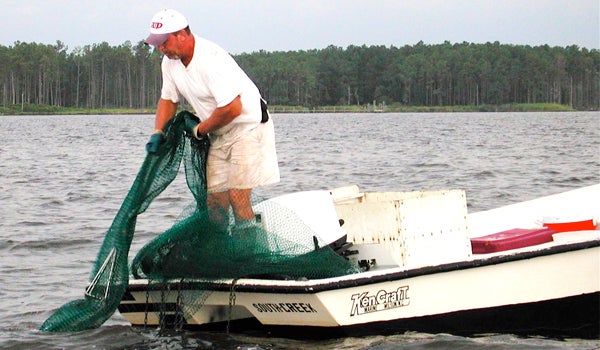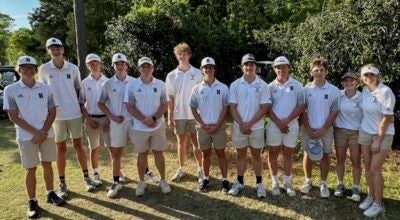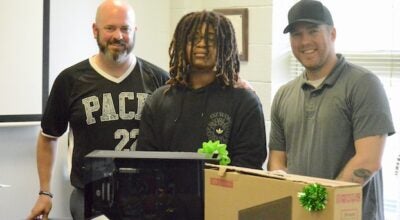Recreational shrimping underway
Published 11:02 am Saturday, July 25, 2015

FRED BONNER | CONTRIBUTED
NICE CATCH: This recreational shrimper is beginning to haul in his trawl net to see if he made a good tow. Note the by-catch reduction devices on the trawl net.
When the 2015 shrimp season opened along some sections of the Pamlico area recently, both commercial and recreational fishermen grabbed their small trawl nets and headed for the water. Many felt that the N.C. Division of Marine Fisheries might have opened the season a bit too early, but, pleasantly surprised, they found that there were a good number of nice sized shrimp to be had.
We eastern North Carolinians were really impressed with the numbers of shrimp we had in our area a couple of years ago. We were casting for speckled trout up in small tidal creeks just off the Pamlico River when we observed that a large number of shrimp skittering around in the shallow waters. We rushed back to home base and retrieved out cast nets and returned to where we had been. It was a bonanza for recreational shrimpers. Some who were really good with a cast net sometime caught a couple of pounds of shrimp with one throw of the net.
Most of the reports that have been coming from the more inland tidal creeks around East Beaufort County and Pamlico County are that this year’s shrimping seems to be limited to trawl netters who have the proper licenses and equipment. The cast netters aren’t having much luck … yet.
Shrimpers that were on the water recently reported that everybody who was out there was being checked by the DMF Marine Police, U.S. Coast Guard and NCWRC Game Wardens. Be advised that it’s a good idea to have all your licenses and safety equipment aboard during these early days of shrimping season.
I don’t think that we Tar Heels will ever have the numbers of shrimp that I saw being taken a few years ago down along the lower Mississippi River near New Orleans. We were staying in a small Cajun village and were mystified one morning when a large number of small boats were observed headed out into the lower bayous and rivers. When we asked our host what was happening, he replied that this was the opening day of the shrimping season and every available boat and skipper was headed out to harvest one of the favorite Louisiana seafood.
Later that evening, we were having a meal of the famous Louisiana oyster Po-boy sandwiches at a local bar and nearly everyone else in the joint was sitting around their tables, eating piles of steamed shrimp. When we remarked that maybe we should just have a few of those steamed shrimp too, the bartender pointed at a huge washtub filled with steamed shrimp.
“Go help yourself,” he replied. “The fishermen have caught so many shrimp today that they couldn’t sell them all. Eat your fill. They’re on the house!”
It was a seafood lover’s bonanza!
Cheryl Gilgo of the DMF’s Fish Eye News tells us that, ”Swimming around out in the ocean and the inland water bodies are some very tasty little creatures.
“Fishermen have harvested these crustaceans since the 1920s and the demand for them still continues. Shrimp are an economic necessity for fishermen, as well as a staple for many dinner tables.
“There are entire communities that evolve around shrimping,” said Scott Crosson, socioeconomic program manager for the N.C. Division of Marine Fisheries. “Whole families participate in catching, unloading and heading shrimp.”
“Shrimp is the second largest commercial fishery in North Carolina, bested only by blue crabs in pounds landed and dockside value.”
“There are primarily three species of shrimp found in North Carolina waters: brown, pink and white shrimp.”
Brown shrimp are the most abundant species and are caught mainly in the summer and have a maximum life span of 18 months. They can grow up to 9-inches long and account for 67 percent of North Carolina’s shrimp landings.
“White shrimp or green tails are the second most abundant and only found in the fall for harvesting,” Crosson said. “They can live up to 24 months and grow up to eight inches. White shrimp bring in 28 percent of North Carolina’s shrimp landings.
“Pink shrimp or spotted shrimp, are the least abundant and are harvested in the spring. They have a maximum life span of 24 months and can grow as large as 11 inches. They account for 5 percent of North Carolina’s shrimp landings.”
“Unfortunately, within the last 30 years or so, shrimp harvesting has been hit the hardest out of all the commercial industries,” Crosson said.
When adjusted for inflation, the price of shrimp has dropped by more than half since the late 1970s. Imported shrimp is a big reason why, Crosson said. Shrimp imports have tripled in the past 10 years.
“Wild American Shrimp is a national campaign that has been developed to educate and promote the harvesting and selling of non-imported or farm-raised shrimp. And for eastern North Carolina there are now two local entities that are a part of a campaign developed by volunteers to promote local seafood through community and business partnerships: Carteret Catch and the newest, Brunswick Catch. Other areas, such as Dare County, are considering similar campaigns as well.”
“Getting fresh shrimp in season is not too difficult in most areas; fish markets and grocery stores are the most common places. Wholesale fish houses often sell shrimp to the general public, too.”
“Consumers should look for clear shrimp — if the meat or shells are orange or pink it is not fresh. Shrimp also should not stink. They should smell like salt water.”
The N.C. Division of Marine Fisheries General regulations for using a cast net are as follows:
• There are no regulations limiting the size of cast nets used in North Carolina coastal waters.
• A cast net may be used year round in all coastal waters of North Carolina.
• Cast nets are considered recreational gear. No license or permit is needed when using a cast net to catch shrimp for recreational purposes.
• Sale of shrimp caught for recreational purposes is prohibited. A commercial fishing license is required to sell catch.
• Rules are different for waters that are open and closed to shrimp trawling. Closed area signs are posted at areas most frequented by cast netters, but not all closed areas are marked. Fishermen should refer to the proclamation section of the North Carolina Division of Marine Fisheries’ website at http://portal.ncdenr.org/web/mf/proclamations for current closed areas.
• When using a cast net in an area closed to shrimp trawling, 4 quarts (heads on) or 2 1⁄2 quarts (heads off) of shrimp per person per day (Cast Net Only)
• 48 quarts (heads on) or 30 quarts (heads off) of shrimp per person per day or if vessel is used, per vessel per day (RCGL max. limit of 2 /vessel)
Catching finfish with a cast net (including bait fish)
• If a cast netter plans to keep any finfish caught, including minnows and/or bait fish, a Coastal Recreational Fishing License is required.
For more information, contact Kevin Brown, with the N.C. Division of Marine Fisheries, at 252-808-8089 or Kevin.H.Brown@ncdenr.gov or Trish Murphey at 252-808-8091 or Trish.Murphey@ncdenr.gov.





